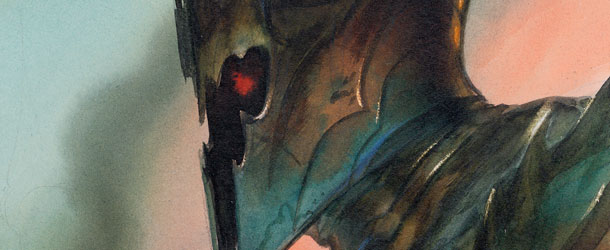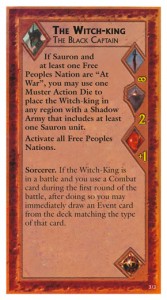Without any doubt, the Witch-king, Lord of Angmar, Black Captain, has an impressive presence both in “The Lord of the Rings” and in War of the Ring.
His entry in the game means an extra Action Dice for the Shadow, a powerful Leadership rating, an impressive ability to use when he’s in battle. He also heralds the coming of total war to Middle-earth, activating all the Free Peoples Nation as a side effect of his apparition.
It’s hard to think of a game that the Shadow can win without making good use of the Witch-king, and his untimely death often heralds the defeat of Sauron.
So, why meddle with him? Well, there is one reason, and WOTR experts call it “card-cycling”.
The original design idea of the sorcerous power of the Witch-king was that he was able to bring its powerful influence and magical spells in a battle, and this was represented by a potentially limit-less access to combat cards, as he draws one when using one card. However, clever WOTR players soon found out a way to exploit this power in a direction which is completely un-intended. They were not drawing cards to improve their battles (or not only for that, at the very least). They were drawing deep into the Character deck to look for all the nasty anti-Fellowship effects.
Nice, isn’t it? Yes, and no. War of the Ring design is all about choices, and this appears in many areas of the game. We like the idea that Sauron must decide whether to go for all-out war, hunting the Fellowship, or balancing the two strategies. But a strategy which allowed you to go on a rampage with the Witch-king and at the same time harassing the Fellowship with Event card effects was just a little too good.
So, when we started to develop the Second Edition rules, modifying the Witch-king was one of our goals since the beginning. Our initial proposal, reflecting the original outlook on the design, was that the card-drawing power should be limited to drawing from the Strategy deck. However, the playtesting proved that this change narrowed the strategies available to the Shadow player too much, making a strategy based on corrupting the Ring-bearers almost impossible to pursue, and leaving an all-out military assault as the only viable strategy for the Shadow. In the end, the change proved to actually be enhancing one of the “extreme” paths to victory, the Shadow Blitz, and blunted any chance for the Shadow to contrast a Fellowship Blitz - quite contrary to our goals in revising the game.
It was Kevin “Krieghund” Chapman who came up first with a suggestion which was quickly embraced by the other playtesters and later actually became a part of the Second Edition: “There seems to be some conjecture that the change to the Witch-king's Sorcerer ability simply steers the Shadow to a military blitz rather than Fellowship hunting. I wonder what would happen if the Shadow player had to draw from the same deck from which the played Combat card came. This might keep the ability from being used for one single purpose, and may make it more balanced. Thoughts?”
This change was soon added to the playtest process and it lasted to the end, and now appears in the published game. The Shadow player could not use any more the Witch-king’s card-cycling to single-mindedly focus on one deck – he could only draw Character cards if he was sacrificing another Character card for use in the battle. In this way he could improve his chances to hunt the Fellowship, but not really exploit the strategy as much as before. The same happened with the Military Blitz – to draw one more Strategy card, another one of the same type had to go.
This was not the only important change for the Black Captain, however. Another issue which we tried to address with the Second Edition, based on feedback by our best players, is the initial imbalance between the Action Dice available to the Shadow and to the Free Peoples. Such a strong imbalance is one of the driving forces behind the “urge” to let go Gandalf the Grey, as we discussed in Part 6, and can seriously hamper the Free Peoples player if he’s not able to get a 5th die soon.
In the original design, we expected the Black Captain, due to his side-effect effect of getting all the Free Peoples Nations activated, to have a mid-game appearance. But, in practice, the most common choice of a good Shadow player is to get him in the game as soon as possible. Clearly, the side-effect was not serious enough to prevent the Shadow player to get the Witch-king in play very early, and this gave very often 9 dice to the Shadow from turn 2 or 3, against 4 dice for the Fellowship, swinging the balance quite in favour of the Shadow.
We considered several ways to approach this issue, as we’ll see in the next article, and one of them was to make the early entrance of the Witch-King something which the Shadow could not take for granted. We’ll go more in depth on this subject when we’ll discuss the changes to the Action Dice mechanics in the next article, but in the meantime you can read here the text and see the card of the new Black Captain. He’s still the most dangerous opponent that the Free Peoples face on the War of the Ring board, but this new version (also combined with the other changes) surely makes the strategies available to both the Shadow Player and the Free Peoples player in the early game quite less obvious than before.
If Sauron and at least one Free Peoples Nation are “At War,” you may use one Muster Action Die to place the Witch-king in any region with a Shadow Army that includes at least one Sauron unit. Activate all Free Peoples Nations. Sorcerer. If the Witch-King is in a battle and you use a Combat card during the first round of the battle, after doing so you may immediately draw an Event card from the deck matching the type of that card.











